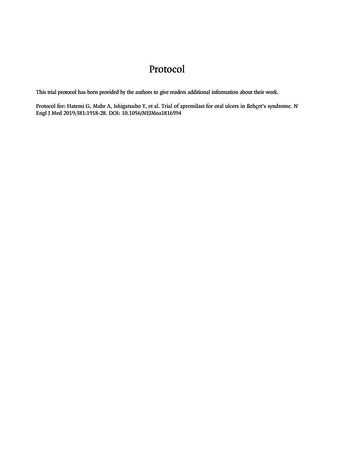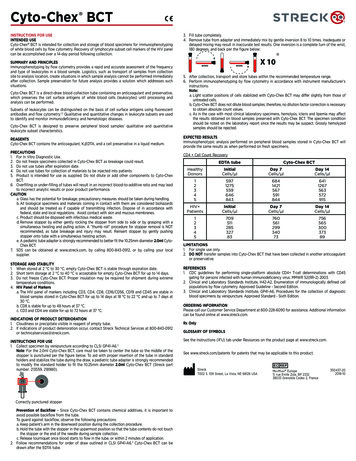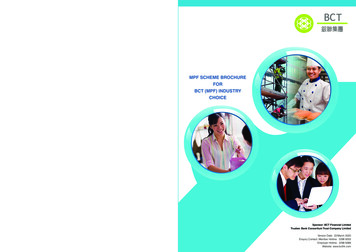
Transcription
ProtocolThis trial protocol has been provided by the authors to give readers additional information about their work.Protocol for: Hatemi G, Mahr A, Ishigatsubo Y, et al. Trial of apremilast for oral ulcers in Behçet’s syndrome. NEngl J Med 2019;381:1918-28. DOI: 10.1056/NEJMoa1816594
This supplement contains the following items:1.2.3.4.Original study protocolFinal study protocolStudy protocol summary of changesOriginal statistical analysis plan**Only one final statistical analysis plan was signed off prior the first data restriction (Week 12database lock). No statistical analysis plan amendments were produced.
CC-10004-BCT-002 Original Study Protocol
ApremilastProtocol CC-10004-BCT-002Celgene CorporationTITLE PAGEA PHASE 3, MULTICENTER, RANDOMIZED, DOUBLEBLIND, PLACEBO-CONTROLLED, PARALLEL GROUPSTUDY, FOLLOWED BY AN ACTIVE-TREATMENTPHASE TO EVALUATE THE EFFICACY AND SAFETYOF APREMILAST (CC-10004) IN THE TREATMENT OFSUBJECTS WITH ACTIVE BEHÇET’S DISEASEINVESTIGATIONAL PRODUCT (IP):Apremilast (CC-10004)PROTOCOL NUMBER:CC-10004-BCT-002DATE FINAL:10 SEP 2014EudraCT NUMBER:2014-002108-25IND NUMBER:101761SPONSOR NAME / ADDRESS:Celgene Corporation86 Morris AvenueSummit, NJ 07901CONFIDENTIALThis protocol is provided to you as an Investigator, potential Investigator, or consultant for review byyou, your staff, and ethics committee/institutional review board. The information contained in thisdocument is regarded as confidential and, except to the extent necessary to obtain informed consent,may not be disclosed to another party unless such disclosure is required by law or regulations.Persons to whom the information is disclosed must be informed that the information is confidentialand may not be further disclosed by them.Confidential and Proprietary1Protocol CC-10004-BCT-002 Final: 10 Sep 2014EDMS Doc. Number: 19824857 - 19739524
ApremilastProtocol CC-10004-BCT-002Celgene CorporationMEDICAL MONITOR / EMERGENCY CONTACT INFORMATIONContact Information: All regions – North America, Europe, APACName:Title:Address:Phone:Toll-free:For Japan:Toll-free Japan only:E-mail:Note: The back-up 24 hour global emergency contact call center should only be used if youare not able to reach the Clinical Research Physician(s) or Medical Monitor or designee foremergency calls.Back-up 24 Hour Global Emergency Contact Call Center:Confidential and Proprietary2Protocol CC-10004-BCT-002 Final: 10 Sep 2014EDMS Doc. Number: 19824857 - 19739524
ApremilastProtocol CC-10004-BCT-002Celgene CorporationCELGENE THERAPEUTIC AREA HEAD SIGNATURE PAGE{See appended electronic signature page}Signature of Celgene Therapeutic Area Headdd mmm yyyyBy my signature, I indicate I have reviewed this protocol and find its content to beacceptable.Confidential and Proprietary3Protocol CC-10004-BCT-002 Final: 10 Sep 2014EDMS Doc. Number: 19824857 - 19739524
ApremilastProtocol CC-10004-BCT-002Celgene CorporationSITE PRINCIPAL INVESTIGATOR SIGNATURE PAGESignature of Site Principal Investigatordd mmm yyyyPrinted Name of Site Principal InvestigatorInstitution Name:By my signature, I agree to personally supervise the conduct of this study at my studysite and to ensure its conduct is in compliance with the protocol, informed consent,Institutional Review Board (IRB)/Ethics Committee (EC) procedures, instructions fromCelgene representatives, the Declaration of Helsinki, ICH Good Clinical PracticesGuidelines, and local regulations governing the conduct of clinical studies.Confidential and Proprietary4Protocol CC-10004-BCT-002 Final: 10 Sep 2014EDMS Doc. Number: 19824857 - 19739524
ApremilastProtocol CC-10004-BCT-002Celgene CorporationCOORDINATING PRINCIPAL INVESTIGATOR SIGNATURE PAGESignature of Coordinating Principal Investigatordd mmm yyyyPrinted Name of Coordinating Principal InvestigatorInstitution Name:By my signature, I agree the protocol has been written to comply with ICH GoodClinical Practices guidelines and agree to offer guidance throughout the study asneeded.Confidential and Proprietary5Protocol CC-10004-BCT-002 Final: 10 Sep 2014EDMS Doc. Number: 19824857 - 19739524
ApremilastProtocol CC-10004-BCT-002Celgene CorporationPROTOCOL SUMMARYStudy TitleA Phase 3, Multicenter, Randomized, Double-blind, Placebo-controlled Parallel Group Study,followed by an Active-Treatment Phase to Evaluate the Efficacy and Safety of Apremilast(CC-10004) in the Treatment of Subjects with Active Behçet’s Disease.IndicationBehçet's disease (BD) is a chronic, relapsing, multisystemic inflammatory disorder characterizedby recurrent oral and genital ulcers, which may be accompanied by cutaneous, ocular, articular,gastrointestinal, and/or central nervous system inflammatory lesions. In some cases, uncontrolledinflammation may lead to blindness, intestinal complications, stroke and even meningitis, whichcan be fatal. The main clinical feature of Behçet's disease is recurrent (exacerbations andremissions) painful oral ulcerations appearing either alone or in combination with painful ulcersof the genitals, as well as lesions of the skin and eyes, and involvement of joints and otherorgans. Oral ulcers are the most frequent sign at onset (Kone-Paut, 1998; Krause, 1999; Alpsoy,2007; Kerkeni, 2010; Atmaca, 2011) being observed in nearly every patient (range, 90% to100% of cases). Genital ulcerations are generally less frequent, occurring in about 80% of adults(range, 55% to 97% of cases).In BD, the pro-inflammatory mediators that are upregulated include the T cell derived cytokinesinterferon (IFN)-γ, interleukin (IL)-2 and IL-17 (Sugi-Ikai, 1998; Frassanito, 1999; Ahmed,2004, Hamzaoui, 2002, Hamzaoui, 2011), as well as IL-1β, IL-6, IL-8, IL-12 and tumor necrosisfactor (TNF)-α (Hamzaoui, 1990; Ozoran 1995, Evereklioglu, 2002; Hamzaoui, 2002). ElevatedIL-12 and IL-17 levels in patients with active BD appear to correlate with disease activity(Frassanito, 1999; Hamzaoui, 2002; Turan, 1997; Hamzaoui, 2011). Together, these dataindicate that pro-inflammatory responses prevail in active BD, and that targeted inhibition of 1 ormore of these mediators may be an effective treatment in BD.Apremilast (CC-10004), an oral small-molecule inhibitor of phosphodiesterase (PDE) 4, worksintracellularly to modulate a network of pro-inflammatory and anti-inflammatory mediators.Phosphodiesterase 4 is a cyclic adenosine monophosphate (cAMP)-specific PDE and thedominant PDE in inflammatory cells. Phosphodiesterase 4 inhibition elevates intracellularcAMP levels, which in turn down-regulates the inflammatory response by modulating theexpression of TNF-α, IL-23, IL-17, and other inflammatory cytokines. Cyclic AMP alsomodulates levels of anti-inflammatory cytokines such as IL-10. Apremilast hasimmunomodulatory activity and, therefore, has the potential to be effective in the treatment ofBD.ObjectivesPrimary Objective: To evaluate the efficacy of apremilast for the treatment of oral ulcers in active Behçet’sdiseaseConfidential and Proprietary6Protocol CC-10004-BCT-002 Final: 10 Sep 2014EDMS Doc. Number: 19824857 - 19739524
ApremilastProtocol CC-10004-BCT-002Celgene CorporationSecondary Objectives: To evaluate the efficacy of apremilast in subjects with active Behçet’s disease To evaluate the effect of apremilast on Patient Reported Outcomes (PROs) in subjectswith active Behçet’s diseaseSafety Objective: To evaluate the safety and tolerability of apremilast in subjects with active Behçet’sdiseaseExploratory Pharmacokinetic/Pharmacodynamic Objectives: To characterize the pharmacokinetics (PK) of apremilast in subjects with active Behçet’sdisease To evaluate the effect of apremilast on inflammatory biomarkers and leukocyte subsetsassociated with active Behçet’s diseaseExploratory Pharmacogenetic Objective: To evaluate pharmacogenetic (PG) markers associated with clinical andpharmacodynamic interaction with apremilast in subjects with active Behçet’s diseaseExploratory Objectives: To evaluate the effect of apremilast on disease activity in subjects with active Behçet’sdiseaseStudy DesignThis is a Phase 3, multicenter, randomized, double-blind, placebo-controlled, parallel groupstudy, followed by an active-treatment phase to evaluate the efficacy and safety of apremilast(CC-10004) in the treatment of subjects with active BD. The study consists of 4 phases: aScreening Phase of up to 6 weeks; a 12-week Double-blind Placebo-controlled Treatment Phase;a 52-week Active Treatment Phase; and a 4-week Posttreatment Observational Follow-up Phase.To estimate the treatment difference for the primary endpoint for the study, approximately 204eligible subjects will be randomized; stratified by gender, history of uveitis and region (Japanand Other). Subjects will be randomized 1:1 to receive apremilast 30 mg twice daily (BID) (APR30 BID), or identically-appearing placebo tablets BID for the 12-week Placebo-controlledTreatment Phase.Upon completion of the Week 12 visit, subjects initially randomized to placebo will transition toAPR 30 BID, while subjects initially randomized to APR 30 BID will continue on the sametreatment during the 52-week Active Treatment Phase. All subjects who complete the ActiveTreatment Phase, as well as all subjects who discontinue at any time from the study for anyreason, are to enter the 4-week Posttreatment Observational Follow-up Phase.Study PopulationMale and female subjects 18 years old at the time of consent, who have BD, meeting theInternational Study Group (ISG) criteria, without major organ involvement, and who have atConfidential and Proprietary7Protocol CC-10004-BCT-002 Final: 10 Sep 2014EDMS Doc. Number: 19824857 - 19739524
ApremilastProtocol CC-10004-BCT-002Celgene Corporationleast 3 oral ulcers at Visit 2 (Baseline Visit; day of randomization), or 2 oral ulcers during theScreening Phase and 2 oral ulcers at Visit 2 (Baseline Visit; day of randomization).Length of StudyTotal duration of the study is up to 74 weeks: Screening Phase — up to 6 weeks Double-blind, Placebo-controlled Treatment Phase — 12 weeks Active Treatment Phase — 52 weeks Posttreatment Observational Follow-up Phase — 4 weeksThe End of Trial is defined as either the date of the last visit of the last subject to complete thestudy, or the date of receipt of the last data point from the last subject that is required forprimary, secondary and/or exploratory analysis, as pre-specified in the protocol and/or theStatistical Analysis Plan, whichever is the later date.Study TreatmentsDouble-blind, Placebo-controlled Treatment Phase: Following a 7-day dose titration, apremilast (30 mg) and identically-appearing placebotablets will be provided and administered orally BIDActive Treatment Phase: Apremilast (30 mg) tablets will be provided and administered orally BIDOverview of Efficacy Assessments Oral ulcer count using area under the time curve (AUC) through Week 12 Visual analogue scale (VAS) to assess pain of oral and genital ulcers separately BD Quality of Life measure BD Current Activity Form Behçet’s Syndrome Activity Score (BSAS) Short-Form 36-Item Version 2 (SF-36v2) Physician’s Global Assessment (PGA) of skin lesions Peripheral Joint Count Evaluation BD-related inflammatory eye disease Manifestations of BD (arthritis, uveitis, gastrointestinal BD, central nervous system[CNS] or vascular manifestations, and/or skin disease) Pharmacokinetic: pharmacokinetic assessments Pharmacodynamic: plasma inflammation markers and leukocyte subsets Pharmacogenetic: genetic biomarkersConfidential and Proprietary8Protocol CC-10004-BCT-002 Final: 10 Sep 2014EDMS Doc. Number: 19824857 - 19739524
ApremilastProtocol CC-10004-BCT-002Celgene CorporationOverview of Safety Assessments Adverse events Vasculitis and psychiatric evaluations Chest radiographs Physical examinations Vital signs Weight measurements Clinical laboratory safety evaluations Manual 12-lead electrocardiograms (ECGs) Pregnancy testConfidential and Proprietary9Protocol CC-10004-BCT-002 Final: 10 Sep 2014EDMS Doc. Number: 19824857 - 19739524
ApremilastProtocol CC-10004-BCT-002Celgene CorporationTABLE OF CONTENTSTITLE PAGE.1PROTOCOL SUMMARY .61.INTRODUCTION.171.1.Behçet’s Disease.171.2.Apremilast .181.2.1.Clinical Safety .191.3.Efficacy and Safety of Apremilast in Behçet’s Disease .201.4.Rationale for Dose Chosen .222.STUDY OBJECTIVES.232.1.Primary Objective.232.2.Secondary Objectives .232.3.Safety Objective .232.4.Exploratory Pharmacokinetic/Pharmacodynamic Objectives.232.5.Exploratory Pharmacogenetic Objective .232.6.Exploratory Objective.233.STUDY ENDPOINTS.243.1.Primary Endpoint.243.2.Secondary Endpoints .243.3.Safety Endpoints.253.4.Exploratory Pharmacokinetic / Pharmacodynamic Endpoints.253.5.Exploratory Pharmacogenetic Endpoint .253.6.Exploratory Endpoint(s).254.OVERALL STUDY DESIGN .274.1.Study Design .274.1.1.Internal Celgene Safety Monitoring During the Apremilast Program: Role ofthe Safety Management Team.274.1.2.External Safety and Efficacy Monitoring During Apremilast Program: Roleof the Independent Data Monitoring Committee .274.2.Study Design Rationale .284.3.Study Duration .294.4.End of Trial .295.TABLE OF EVENTS .30Confidential and Proprietary10Protocol CC-10004-BCT-002 Final: 10 Sep 2014EDMS Doc. Number: 19824857 - 19739524
ApremilastProtocol CC-10004-BCT-002Celgene Corporation6.PROCEDURES .346.1.Informed Consent .346.2.Demographic Data.346.3.Complete Medical History .346.4.Inclusion/Exclusion Criteria.346.5.Prior and Concomitant Medications .346.6.Safety Assessments.346.6.1.Adverse Events.346.6.1.1.Adverse Events of Special Interest.356.6.2.Vital Signs, Height and Weight.356.6.3.Complete Physical Examinations .356.6.4.Limited Physical Examinations.356.6.5.Vasculitis Assessment .356.6.6.Psychiatric Evaluation .366.6.7.Clinical Laboratory Evaluations.366.6.7.1.Hematology .366.6.7.2.Serum Chemistry.376.6.7.3.Urinalysis .376.6.7.4.Hepatitis Testing.376.6.8.Contraception Education.376.6.9.Pregnancy Tests for Females of Childbearing Potential.386.6.10.Chest Radiograph .386.6.11.12-lead ECG.386.7.Efficacy Assessments .386.7.1.Number of Oral and Genital Ulcers.386.7.2.Pain VAS for Oral and Genital Ulcers .396.7.3.BD Current Activity Form .396.7.4.Behçet’s Disease Quality of Life Measure .396.7.5.Behçet’s Syndrome Activity Score .396.7.6.Short Form 36-Item Health Survey, Version 2 (SF-36v2 ) .396.7.7.Physician’s Global Assessment of Skin Lesions.406.7.8.Peripheral Joint Count Evaluation.406.7.9.Assessment of Behçet’s Disease-related Inflammatory Eye Disease.40Confidential and Proprietary11Protocol CC-10004-BCT-002 Final: 10 Sep 2014EDMS Doc. Number: 19824857 - 19739524
ApremilastProtocol CC-10004-BCT-002Celgene Corporation6.7.10.Manifestations of Behçet’s Disease.406.7.10.1.Worsening of Behçet’s Disease Requiring Prohibited Medication.406.7.11.Blood Collection for Pharmacokinetic Analysis .416.7.12.Pharmacodynamic Analysis .416.7.12.1.Plasma Proteins .416.7.12.2.Leukocyte Subsets .426.7.13.Pharmacogenetic Analysis .426.8.Investigational Product .426.8.1.Study Medication Dispensing and Counting .426.8.2.Site Instructions for Dosing the Subject .436.9.Investigational Product Discontinuation.436.10.Early Termination Visit .436.10.1.Lost to Follow-up .436.11.Study Completion .437.STUDY POPULATION .457.1.Number of Subjects and Sites .457.2.Inclusion Criteria .457.3.Exclusion Criteria .478.DESCRIPTION OF STUDY TREATMENTS .498.1.Description of Investigational Product .498.2.Description of Placebo.498.3.Treatment Administration and Schedule .498.3.1.Dose Modification or Interruption.518.3.2.Overdose .518.4.Method of Treatment Assignment.518.4.1.Placebo-controlled Treatment Phase (12 Weeks) .518.4.2.Active Treatment Phase (52 Weeks) .518.5.Packaging and Labeling.518.6.Investigational Product Accountability and Disposal .528.6.1.Investigational Product Accountability .528.6.2.Record of Administration .528.7.Investigational Product Compliance.529.CONCOMITANT MEDICATIONS AND PROCEDURES.53Confidential and Proprietary12Protocol CC-10004-BCT-002 Final: 10 Sep 2014EDMS Doc. Number: 19824857 - 19739524
ApremilastProtocol CC-10004-BCT-002Celgene Corporation9.1.Permitted Concomitant Medications and Procedures.539.2.Prohibited Concomitant Medications and Procedures.539.3.Required Concomitant Medications and Procedures.5410.STATISTICAL ANALYSES.5510.1.Overview.5510.2.Study Population Definitions .5510.3.Sample Size and Power Considerations.5510.4.Background and Demographic Characteristics .5510.5.Subject Disposition.5510.6.Efficacy Analysis.5610.6.1.Efficacy Evaluation for the Double-blind, Placebo-controlled TreatmentPhase .5610.6.1.1.Multiplicity.5610.6.1.2.Primary Analysis for Primary Efficacy Endpoint .5610.6.1.3.Analysis for Secondary Efficacy and Exploratory Endpoints .5610.6.2.Efficacy Evaluation for the Active Treatment Phase .5710.7.Safety Analysis.5710.8.Interim Analysis .5710.9.Other dynamic Assessments.5810.9.3.Pharmacogenetic Assessments.5811.ADVERSE EVENTS.5911.1.Monitoring, Recording and Reporting of Adverse Events .5911.1.1.Monitoring, Recording and Reporting AEs of Diarrhea.5911.2.Evaluation of Adverse Events .6011.2.1.Seriousness.6011.2.2.Severity / Intensity.6111.2.3.Causality .6111.2.4.Duration .6211.2.5.Action Taken .6211.2.6.Outcome .6211.3.Abnormal Laboratory Values.62Confidential and Proprietary13Protocol CC-10004-BCT-002 Final: 10 Sep 2014EDMS Doc. Number: 19824857 - 19739524
ApremilastProtocol CC-10004-BCT-002Celgene Corporation11.4.Pregnancy.6311.4.1.Females of Childbearing Potential .6311.4.2.Male Subjects .6311.5.Reporting of Serious Adverse Events.6311.5.1.Safety Queries .6411.6.Expedited Reporting of Adverse Events.6412.DISCONTINUATIONS .6613.EMERGENCY PROCEDURES .6713.1.Emergency Contact.6713.2.Emergency Identification of Investigational Products .6714.REGULATORY CONSIDERATIONS.6814.1.Good Clinical Practice .6814.2.Investigator Responsibilities .6814.3.Subject Information and Informed Consent.6814.4.Confidentiality.6914.5.Protocol Amendments.6914.6.Institutional Review Board/Independent Ethics Committee Review andApproval .6914.7.Ongoing Information for Institut
Back-up 24 Hour Global Emergency Contact Call Center: EDMS Doc. Number: 19824857 - 19739524 Apremilast Protocol CC-10004-BCT-002 Celgene Corporation










